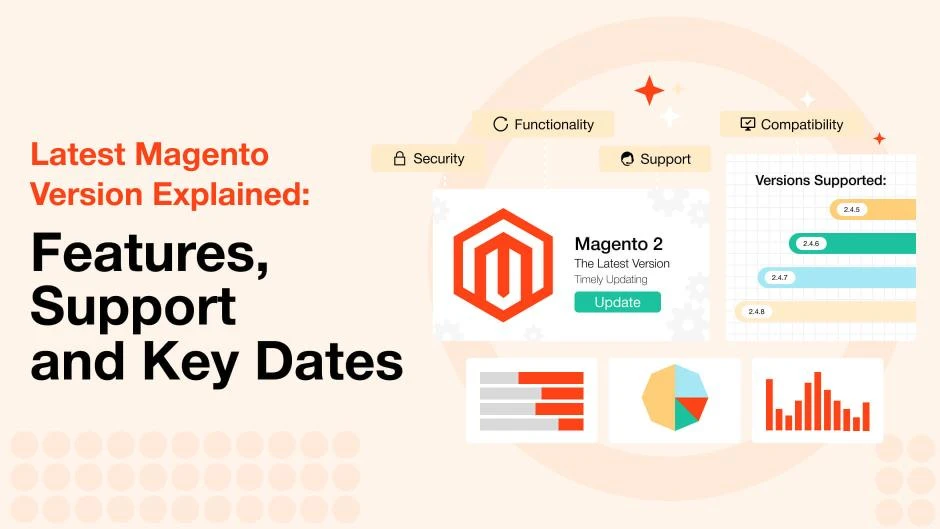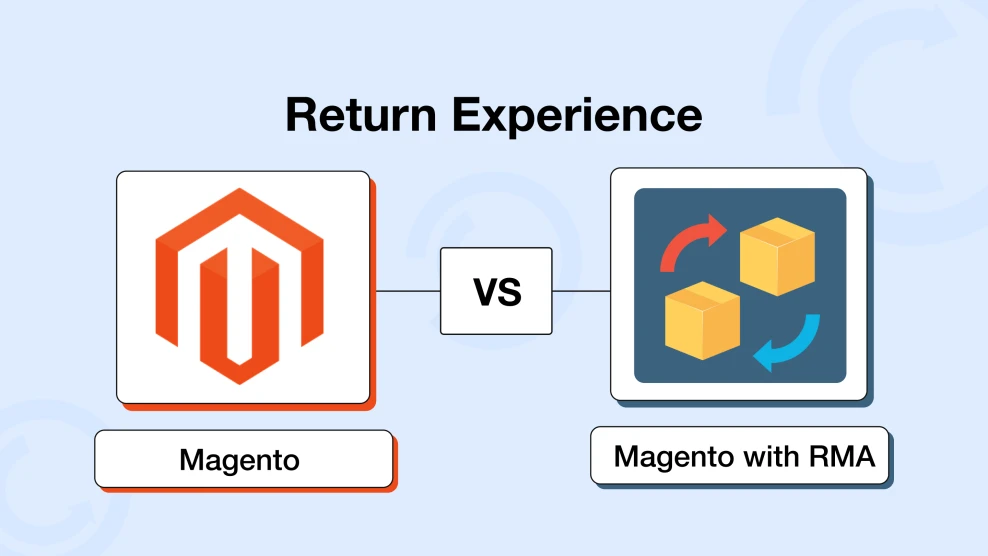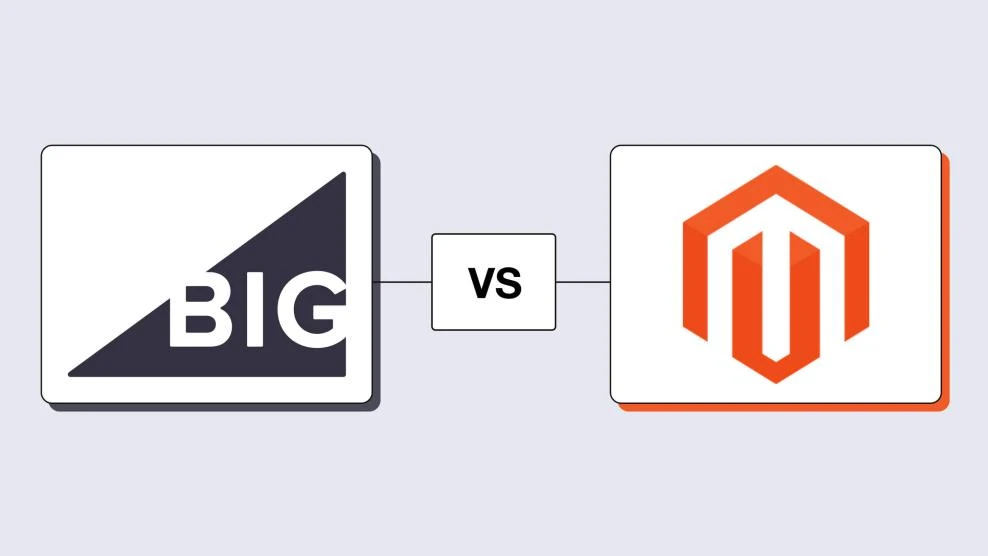Magento Latest Version: Release Details and Features
-
 Anton Gurtovoi
Anton Gurtovoi
- Magento 2
- May 23, 2025
- 11 min read
Like any other big online platform, Magento constantly improves itself. With the rise of new technology, demand for new features, and bugs that should be fixed, new updates are always near. In this article, we will discuss all Magento 2 release versions – what they bring, why updating is important, and the latest version of Magento. So, let’s dive in!
Table of Contents
- Why does timely updating matter?
- From Magento 1 to Magento 2
- Magento 2 releases
- Latest Magento 2.4.8 version (April 2025) — What’s New?
- What Magento versions are not supported anymore?
- Magento current version summary
Why does timely updating matter?
Every active shop should eventually update its Magento software. There are many reasons, but we will recount only the most important ones. Here is why you should always get the newest Magento 2 version:
- Security. Bug fixes and security enhancements are among the most important reasons to update your Magento. Many versions either fix errors or improve safety alongside other changes. So, newer versions – smoother commerce.
- Functionality. Magento updates often bring new features and abilities. The platform's toolkit is constantly expanded, so updating helps you stay at the top performance. You may not need some additions, but they are generally worth the time spent on updating.
- Compatibility. Shop modules are also being updated alongside Magento itself. Some extensions provide backward compatibility, but others don’t. Timely updates may ensure that no module will suddenly switch off.
- Support. Adobe does not support every Magento version. Old releases often receive no maintenance or fixes. You must update Magento to newer versions to stay in the supported version group.
From Magento 1 to Magento 2
Despite the finished end-of-life cycle, many shops still use the Magento 1.0 platform. Their long history mostly causes this devotion. The transition may be problematic when you have a dozen old modules, a big database, and a custom theme. However, Magento 2 is a straight upgrade to the previous version.
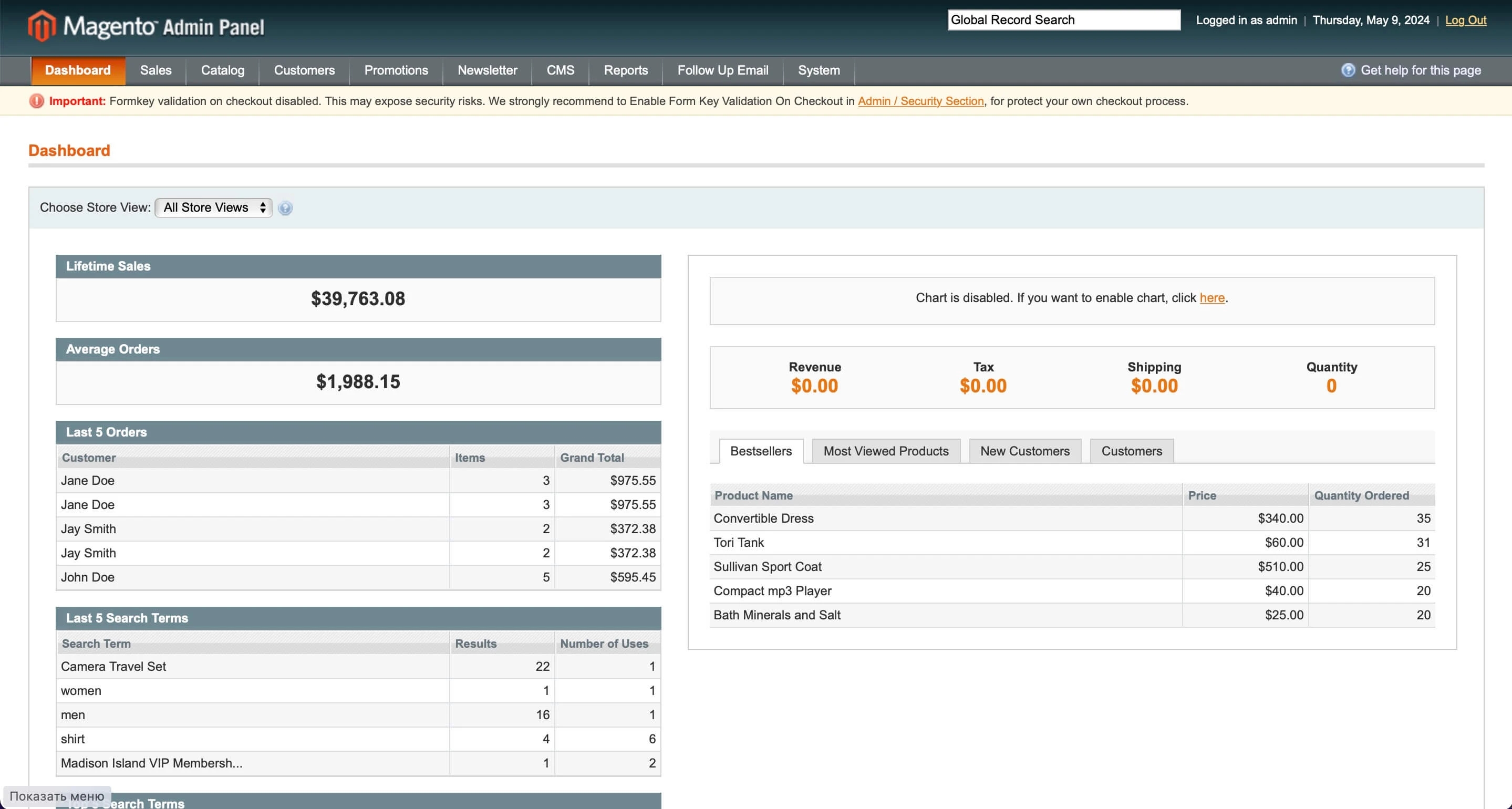
Recounting all the changes stacked over the years will take a long time. So, let’s go over the main improvements from version 1 to 2:
- Tech. All the technology responsible for running the platform was updated. PHP, HTML, JavaScript, and others – Magento 2 uses newer versions, allowing for the implementation of more complex features.
- Performance. Magento 2 has a significantly faster loading time. It requires additional modules to improve performance, but Magento 1 was even slower. On average, back then, the pages loaded for two whole seconds.
- Security. The latest version of Magento receives bug fixes, security updates, and customer support. If any new vulnerabilities are discovered – they will likely be left untouched.
- Design. Magento 1.0 has an outdated, clunky UI. Newer Magento 2 has a more practical than pretty design, but it is still easier to navigate.
- Compatibility. The latest version of Magento 2 supports many more extensions. Some of them are unique to newer releases because of the new tech used in them. Magento 2 also handles mobile compatibility much better than Magento 1.0.
Magento 2 releases
Magento release 2.0 to 2.1
Versions 2.0.1 to 2.0.18 mostly focused on correcting security and performance issues.
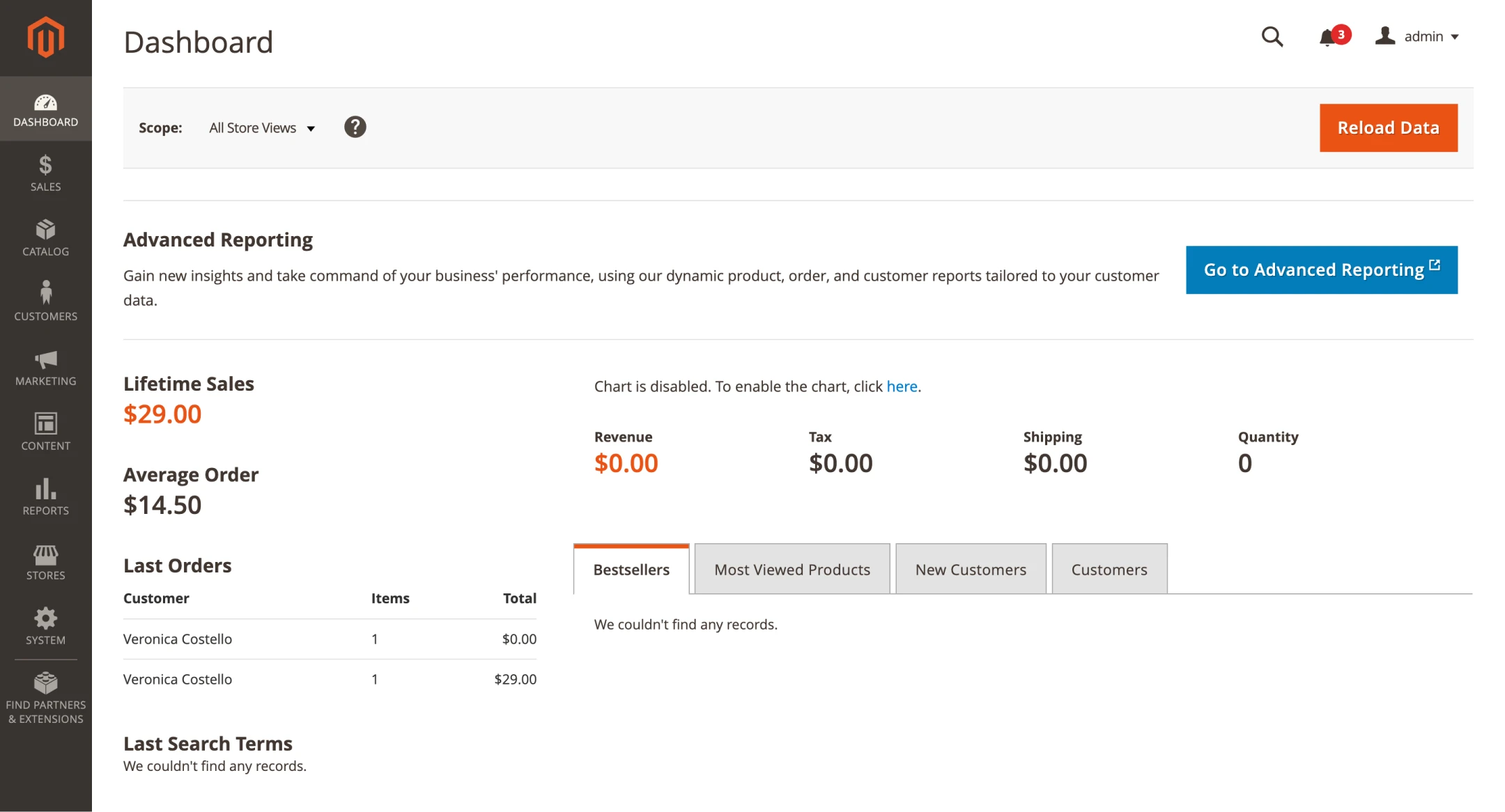
After the release of the 2.0 version, developers were mostly concerned with catching new bugs and exploits. Recounting them will not be very useful or entertaining. Just keep in mind that all updates improved performance and fixed bugs.
However, there were a few notable changes. For example, PHP 7.0.2 and the latest USPS API were now supported. The platform was also brought up to date with PayPal’s IPN changes.
Magento 2 versions 2.1 to 2.2
Versions 2.1.0 to 2.1.18 introduced new PayPal and Braintree functionality and an improved interface.
With this update, clients could use PayPal without leaving the shop. Also, they were allowed to save bank card data for further payments.
Users had to comply with PCI standards to collect payment data safely. The checkout page could now be changed, and the process of creating products and categories was improved. Also, the Braintree settlement reports arrived in the Magento admin panel.
2.1.* versions gained the support of the PHP 5.6.5 and 7.0.4, as well as MySQL 5.7.
Magento versions 2.2 to 2.3
Versions 2.2.0 to 2.2.11 brought many new features, such as reporting, shipping and payment improvements, email automation, instant purchases, and more.
Merchants received 20 pre-built reports, such as abandoned carts reports for their shops. Returning clients could now make payments instantaneously through zero-step checkouts. With the Dotmailer integrations, merchants could now automate mailing. New payment and shipping methods were introduced.
One feature was deleted in this version. The built-in social network integration was removed. However, community contributions were added in large quantities from these versions forward. For example, 2.2.4 saw almost 200 implemented contributions.
These Magento 2 versions also brought Elasticsearch 5 and the first cross-platform tests. PHP 5.6 and Varnish 3 are no longer supported because of the implementation of PHP 7.1 and Varnish 5.
Magento 2 release versions 2.3 to 2.4
Versions 2.3.0 to 2.3.7 added the page builder, PWA studio, GraphQL API, Amazon Sales Channel, MSI, and more third-party extensions.
These versions finally introduced a new page builder with a drag-and-drop UI. These updates also brought PWA Studio, which allowed the implementation of new functionality. For example, PWA Studio made offline mode and push notifications possible.
Inventory management can now be multi-channeled. Now, you can manage several physical locations without third-party modules. Integration with Amazon Sales allowed to process orders from Amazon customers.
GraphQL API was implemented as an alternative to REST and SOAP. Yotpo was now innately integrated, and Dotdigital, Klarna, and Vertex received new features.
Magento 2 releases – 2.4.0 to 2.4.6 versions list
Versions 2.4.0 to 2.4.6 have seen many big changes. Lots of features were reworked, replaced, discontinued, and merged. That is why it makes more sense to review each version individually.
2.4.0
Two-factor authentication for admins not only arrived as a feature but became a forced requirement. Admins could also license preview stock images without leaving the media gallery. Partial-word search in the backend was implemented as the Elastisearch became the default search system.
Admins can now see the store from the users’ perspectives and gain access to their accounts from the frontend. A new seller-assisted shopping feature enabled these abilities. Also, PHP 7.4, Elasticsearch 7.6.*, MySQL 8.0 and MariaDB 10.4 were now supported.
However, some features were removed. Third-party payment methods can now be accessed only through dedicated modules. The Web Set-Up Wizard was no longer available. A simple command-line setup process replaced it.
2.4.1
The new Media Gallery was one of the biggest changes in this Magento release. It allowed bulk actions, duplicate and unused image detection, filtration, and image metadata access.
GraphQL now covers many more functions, such as order history, gifts, clients’ accounts, product reviews, and more. PWA Studio was updated to version 8.0. Lastly, the CAPTCHA is now present on the storefront page for order placement.
2.4.2
GraphQL now supports even more features. It works with multiple wish lists, Return Merchandise Authorization (RMA), and B2B elements such as companies, credits, and requisition lists. Regarding B2B features, this update also included custom email templates and support for third-party payment methods in this sector.
Elasticsearch was updated to 7.9, Redis to 6, Composer to 2, and Varnish to 6.4.
2.4.3
This Magento version primarily focused on fixes, performance improvements, and tech updates. There were no big new features, only little functionality expansions. For example, reCAPTCHA could now be placed in more spots on the website.
2.4.4
In this version of Magento, expanded accessibility for clients with limited and lost vision was introduced. For this purpose, icons and buttons were redesigned, tooltips were improved, and screen elements were properly tagged.
Elasticsearch 7.16, together with OpenSearch 1.2, is now supported. OpenSearch also became the default search system for Magento Open Source. Venmo payments are also supported now.
2.4.5
This version made the Venia storefront even more accessible. Now, people using screen readers get summaries of search results. They are also alerted with every new page load. Additionally, the keyboard has been made more accessible and visible.
Customers can now sign contracts electronically during checkout with the Adobe Sign feature. This includes warranty papers, purchase agreements, and terms and conditions. Adobe ID can also be used to log into the Commerce.
Composer 2.2, jQueryUI 1.13.1, TinyMCE 5.10.2, and DHL Integration schema v6.2 are now supported. PWA storefronts can now gather information about customer behavior. The addition of GTags expanded the capabilities of AdWords and Analytics.
2.4.6
This version focused on improving the PWA storefront, security, and performance. Accessibility in Venia was also improved. For example, shop buttons received more easily comprehensible names. PHP 8.2 support, Redis 7.0, OpenSearch 2.5, Elasticsearch 8, and others were added.
Magento 2.4.7 version
The 2.4.7 Magento 2 version, was released on April 8, 2024. As always, the new update brought bug fixes and security enhancements. More than 150 fixes were implemented. Instead of recounting every small enhancement, let’s go over the main changes.
Security
- Earlier, it was possible to overwhelm the system with automatically generated coupons. To fix this, Magento Open Source now has limitations. By default, you can generate up to 250,000 coupons, no more. However, if you need more, you can increase the quantity using the "Code Quantity Limit" option in the admin panel.
- The default admin URL generation was changed. It now generates more random URLs with fewer repeating patterns, making them harder to guess.
- Now, Subresource Integrity (SRI) is supported. This feature meets PCI 4.0 demands by checking and approving the integrity of scripts on payment pages. It is mainly used on payment pages, but other pages can also be connected to this feature.
- Adobe Commerce's Content Security Policies (CSPs) were improved. These changes ensure compliance with PCI 4.0 demands.
- A default limit for payment information sent through REST and GraphQL APIs was implemented. Merchants can change the limit, but situations where users try many cards simultaneously (card attacks), can now be easily avoided.
Platform
The current version of the Magento Open Source platform has updated many tech features. Here is the list of newly supported upgrades:
- PHP 8.3
- RabbitMQ 3.13
- Composer 2.7.*
- Varnish cache 7.4
- OpenSearch 2.12 and OpenSearch 1.3
- Redis 7.2
Also, all JavaScript libraries, NPM dependencies, and Laminas library dependencies reached the latest possible versions.
Braintree
Customers who saved their PayPal account can now choose other payment methods. For example, Pay Now allows users to pay with the default card without logging into PayPal. They can also pay with another funding source or account. Additionally, they can now choose PayPal Pay Later or PayPal Credit services.
Also, users can now save (vault) payments from different sources to use in later transactions. Users can now vault Google Pay, Apple Pay, Venmo, and ACH transactions. Before, payment details could be saved only during a transaction at checkout. New cards and PayPal accounts can be vaulted anytime without starting a transaction.
The Express Payment can now appear at the start of the checkout process. Customers can quickly pay using PayPal, Pay Later, Apple Pay, or Google Pay Express.
Other enhancements
Magento Open Source 2.4.7 comes with several GraphQL improvements. It has better caching and can handle custom attributes in its GraphQL schema. It also allows headless order cancellation and has improved resolver caching. The update also offers better support for GraphQL custom attributes.
Community-developed Inventory Management version 1.2.7 is now supported as well. It's now a part of Adobe Commerce and Magento Open Source core code.
Latest Magento 2.4.8 version (April 2025) — What’s New?
Updated (May 2025)
Magento 2.4.8 is the latest version available as of April 2025. It delivers important updates to platform compatibility, performance, and security. This version is available for Magento Open Source, Adobe Commerce, and Adobe Commerce Cloud.
It continues Adobe’s effort to improve the platform’s stability, security, and performance. The update includes over 500 fixes and enhancements, as well as new platform support and API upgrades.
Let’s explore the most notable changes.
Security
Magento 2.4.8 addresses vulnerabilities like XSS and XML injection. Two-factor authentication was updated with the new Duo SDK. The Subresource Integrity (SRI) feature introduced earlier was improved, providing better script validation across payment pages.
The Admin UI for encryption key management was removed. Instead, a new CLI-based tool now handles key rotation, making the process more secure.
A rate limit was implemented for sensitive API endpoints, helping prevent brute-force attacks through REST and GraphQL.
Platform
- The latest release updates many core technologies:
- PHP 8.4 is now supported (PHP 8.1 is no longer supported)
- MariaDB 11.4 and MySQL 8.4 are now supported
- Elasticsearch is deprecated and replaced by OpenSearch 2.19
- Composer 2.8, RabbitMQ 4.x, Redis 7, Valkey 8, and Varnish 7.6 are supported
The indexer now defaults to "Update by Schedule", reducing the impact of real-time indexing on store performance.
Checkout and Payments
The Braintree integration has been updated. It now supports Apple Pay and Google Pay line-item display and offers a smoother express checkout experience. Payment methods like Sofort and Giropay were removed due to low usage.
Orders with zero total now automatically select “Free” as the payment method.
GraphQL and Performance
Magento 2.4.8 expands GraphQL support with new fields and better error messaging. It improves performance for both headless builds and traditional stores, especially during large catalog updates and price changes.
B2B features on Adobe Commerce also benefit from improved support for company-specific pricing, shared catalogs, and API stability.
Admin and developer tools
- TinyMCE was upgraded to version 6.8.5 (TinyMCE 5 is removed)
- PHPUnit 10 and RequireJS 2.3.7 are supported
- Inventory syncing is more reliable due to internal indexing changes
What Magento versions are not supported anymore?
As of this release, only four Magento 2 versions remain supported: 2.4.5, 2.4.6, 2.4.7, and 2.4.8. Older versions no longer receive bug fixes or security updates.
Support timelines
| Magento version | Support end date |
|---|---|
| 2.4.4 | April 24, 2025 |
| 2.4.5 | August 9, 2025 |
| 2.4.6 | March 14, 2026 |
| 2.4.7 | April 2027 |
| 2.4.8 | April 2028 |
Magento current version summary
So, what is the current version of Magento 2?
As of April 2025, it is version 2.4.8. This version brings the longest support window, updated PHP compatibility, and improved GraphQL, checkout, and performance handling.

